-
 Bitcoin
Bitcoin $117900
-1.36% -
 Ethereum
Ethereum $3579
-3.25% -
 XRP
XRP $3.123
-11.35% -
 Tether USDt
Tether USDt $1.000
-0.01% -
 BNB
BNB $765.4
-1.41% -
 Solana
Solana $187.0
-6.55% -
 USDC
USDC $0.9999
0.00% -
 Dogecoin
Dogecoin $0.2376
-9.95% -
 TRON
TRON $0.3064
-2.32% -
 Cardano
Cardano $0.8027
-9.57% -
 Hyperliquid
Hyperliquid $43.20
-3.41% -
 Stellar
Stellar $0.4190
-10.58% -
 Sui
Sui $3.657
-7.55% -
 Chainlink
Chainlink $17.91
-7.84% -
 Hedera
Hedera $0.2438
-9.88% -
 Bitcoin Cash
Bitcoin Cash $505.9
-2.55% -
 Avalanche
Avalanche $23.63
-6.53% -
 Litecoin
Litecoin $110.9
-5.61% -
 UNUS SED LEO
UNUS SED LEO $8.969
-0.03% -
 Shiba Inu
Shiba Inu $0.00001368
-10.13% -
 Toncoin
Toncoin $3.155
-5.74% -
 Ethena USDe
Ethena USDe $1.001
-0.01% -
 Polkadot
Polkadot $4.082
-8.38% -
 Uniswap
Uniswap $9.951
-6.29% -
 Monero
Monero $309.9
-2.47% -
 Bitget Token
Bitget Token $4.656
-3.04% -
 Dai
Dai $0.0000
0.01% -
 Pepe
Pepe $0.00001253
-9.22% -
 Aave
Aave $287.4
-5.98% -
 Bittensor
Bittensor $419.3
-5.34%
Do miners still get fees after all Bitcoin is mined?
After Bitcoin's final halving around 2140, miners will rely solely on transaction fees, which must remain sufficient to secure the network as block rewards diminish to zero.
Jul 23, 2025 at 07:42 pm
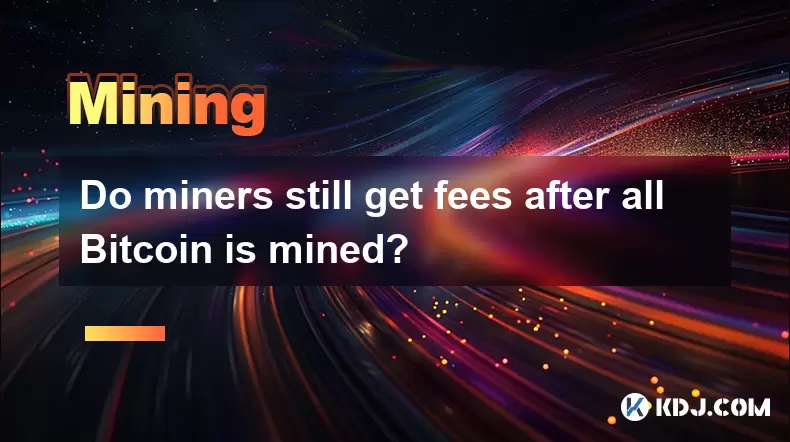
Understanding Bitcoin’s Block Reward Structure
The Bitcoin network relies on miners to validate transactions and secure the blockchain. Miners are compensated through two primary mechanisms: the block reward and transaction fees. The block reward is newly minted Bitcoin (BTC) given to the miner who successfully adds a new block to the blockchain. This reward undergoes a process known as halving, which occurs approximately every four years (every 210,000 blocks), reducing the amount of BTC issued per block by 50%. The last halving occurred in 2024, and this process will continue until the total supply of 21 million BTC is reached.
Once all 21 million Bitcoins have been mined—projected to happen around the year 2140—the block reward will effectively reach zero. At that point, miners will no longer receive newly created Bitcoin for mining a block. However, this does not mean mining will cease to be economically viable. The incentive will shift entirely to transaction fees paid by users to have their transactions included in a block.
The Role of Transaction Fees Post-Mining
After the final Bitcoin is mined, miners will rely solely on transaction fees for income. These fees are determined by users when they initiate transactions. Users can choose to attach a higher fee to prioritize faster confirmation, or a lower fee if they are willing to wait. The fee market operates on supply and demand: when network congestion is high, fees increase as users compete for limited block space.
Miners will continue to select transactions with the highest fees per byte to maximize their earnings. This creates an economic incentive for miners to remain active even without block rewards. As long as there is demand to transact on the Bitcoin network, users will pay fees, and miners will have a reason to validate and secure those transactions.
How Miners Select Transactions
Miners use a process called transaction prioritization to determine which transactions to include in a block. This process is automated through mining software and follows these general principles:
- Transactions are collected in a mempool, a temporary holding area for unconfirmed transactions.
- Each transaction includes a fee, typically measured in satoshis per virtual byte (sat/vB).
- Mining software sorts transactions by fee rate, placing the highest-paying ones at the top.
- Miners construct a block by selecting the most profitable transactions until the block reaches its size limit (currently 4MB with SegWit).
- The selected transactions are then bundled into a candidate block and hashed repeatedly to solve the proof-of-work puzzle.
This mechanism ensures that miners are rewarded for including transactions that users are willing to pay more for, aligning their economic interests with network efficiency.
Will Mining Remain Profitable Without Block Rewards?
The long-term profitability of mining depends on several factors, including network usage, fee levels, and mining costs. While the block reward will disappear, the continued demand for Bitcoin transactions could sustain mining activity. For example, if Bitcoin remains a widely used store of value or medium of exchange, transaction volume—and thus fee revenue—could remain high.
Mining profitability also hinges on hardware efficiency and electricity costs. As older, less efficient mining rigs become obsolete, the network will likely be dominated by highly optimized operations. These operations will need to ensure that the aggregate transaction fees per block exceed their operational costs. Economic models suggest that if Bitcoin maintains its utility and adoption, fee income could be sufficient to support a secure and decentralized mining ecosystem.
Network Security Implications After Full Mining
One concern often raised is whether the Bitcoin network will remain secure once block rewards are gone. Security is directly tied to the total hash rate, which reflects the computational power dedicated to mining. A high hash rate makes it prohibitively expensive for attackers to attempt a 51% attack.
If transaction fees are sufficient to incentivize miners, the hash rate should remain robust. However, a sudden drop in transaction volume or fee income could reduce mining profitability, potentially leading to hash rate centralization or decreased security. To mitigate this, the Bitcoin protocol may see future upgrades that optimize fee structures or block space usage, such as improvements in batching, Schnorr signatures, or Taproot-enabled smart contracts that reduce data load.
Preparing for the Post-Reward Era
The transition to a fee-only model is not abrupt—it will occur gradually over more than a century. This extended timeline allows the ecosystem to adapt. Wallet software may evolve to include dynamic fee estimation, helping users pay appropriate fees without overpaying. Layer-2 solutions like the Lightning Network could also reduce on-chain transaction load, preserving block space for higher-value transfers and ensuring fee competitiveness.
Moreover, as the block reward diminishes, the importance of fee predictability increases. Miners may adopt strategies such as fee sniping or child-pays-for-parent (CPFP) to maximize income. Exchanges and large transaction senders may also coordinate transaction batching to reduce fees, indirectly influencing miner revenue streams.
Frequently Asked Questions
Will miners stop working when no new Bitcoin is created?
No, miners will continue to operate as long as they can earn transaction fees. The absence of block rewards does not eliminate their income source. As long as users pay fees to transact, miners have an economic incentive to validate blocks and maintain network security.
Can transaction fees alone secure the Bitcoin network?
Yes, provided that the total fee revenue per block is sufficient to cover mining costs and offer profit. Historical trends and economic modeling suggest that if Bitcoin retains its utility, fee income could support a secure network, especially with advancements in transaction efficiency and demand growth.
What happens if transaction fees are too low to support miners?
If fees fall below profitability thresholds, some miners may shut down, leading to a temporary drop in hash rate. This could increase vulnerability to attacks. However, the network’s difficulty adjustment mechanism would eventually lower mining difficulty, restoring equilibrium and attracting miners back when conditions improve.
Could Bitcoin introduce a new form of reward after 21 million coins?
No, the 21 million supply cap is hardcoded into Bitcoin’s protocol and cannot be changed without near-universal consensus. Any attempt to alter this would result in a hard fork, creating a new cryptocurrency. The original Bitcoin network will maintain its fixed supply, relying solely on fees post-mining.
Disclaimer:info@kdj.com
The information provided is not trading advice. kdj.com does not assume any responsibility for any investments made based on the information provided in this article. Cryptocurrencies are highly volatile and it is highly recommended that you invest with caution after thorough research!
If you believe that the content used on this website infringes your copyright, please contact us immediately (info@kdj.com) and we will delete it promptly.
- Dogecoin's Resistance Retest: Parabolic Move on the Horizon?
- 2025-07-24 04:50:13
- WLFI, Vaulta Token, and Holdings: Navigating the Web3 Revolution
- 2025-07-24 05:30:13
- BlockDAG, Dogecoin, and the $350M Presale Frenzy: What's Hot Now?
- 2025-07-24 04:50:13
- Ethereum, Meme Coins, and Presale Funding: What's the Hype?
- 2025-07-24 05:30:13
- Ethereum Meme Coin Presales: Hype or the Future?
- 2025-07-24 05:35:13
- ADA's Rocky Ride: Support Levels and Open Interest Under Scrutiny
- 2025-07-24 05:35:13
Related knowledge
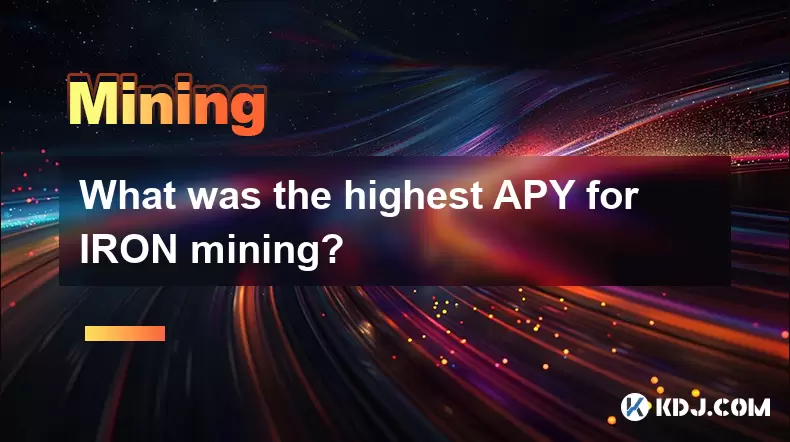
What was the highest APY for IRON mining?
Jul 23,2025 at 05:14am
Understanding IRON Token and Its Mining MechanismThe IRON token is a stablecoin that operates within the Iron Finance ecosystem, primarily on blockcha...

What is impermanent loss in IRON pools?
Jul 23,2025 at 09:00am
Understanding Impermanent Loss in the Context of IRON PoolsImpermanent loss is a phenomenon that affects liquidity providers in decentralized finance ...
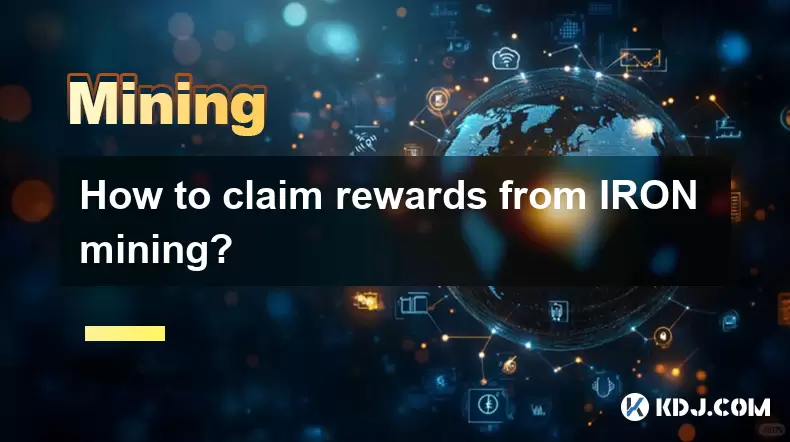
How to claim rewards from IRON mining?
Jul 23,2025 at 02:21pm
Understanding IRON Mining and Reward MechanismsIRON Finance operated as a decentralized finance (DeFi) protocol on the Polygon and Binance Smart Chain...
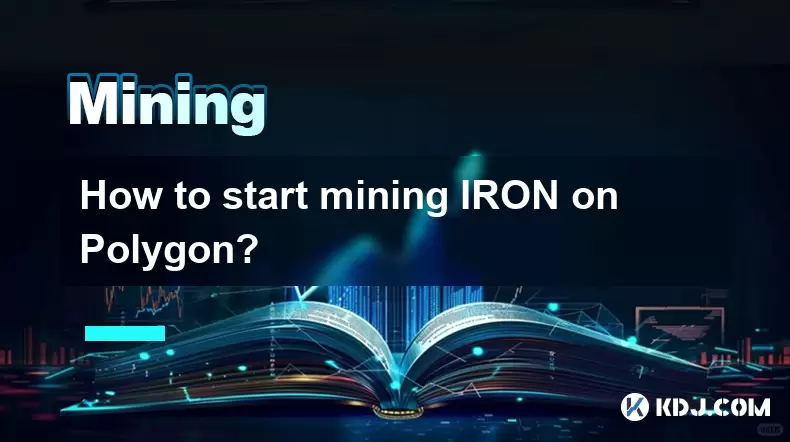
How to start mining IRON on Polygon?
Jul 23,2025 at 08:00pm
Understanding IRON and Its Role on PolygonIRON is a decentralized, algorithmic stablecoin designed to maintain a 1:1 peg with the US dollar. It operat...
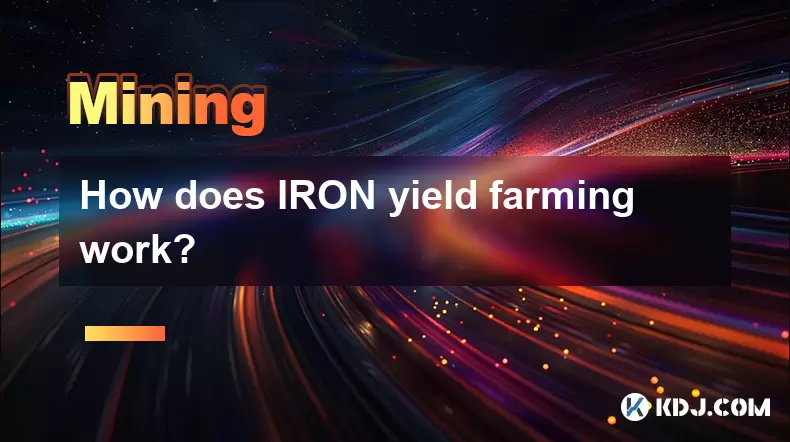
How does IRON yield farming work?
Jul 23,2025 at 10:14pm
Understanding IRON Yield Farming and Its Core MechanismIRON yield farming is a decentralized finance (DeFi) strategy that allows users to earn rewards...
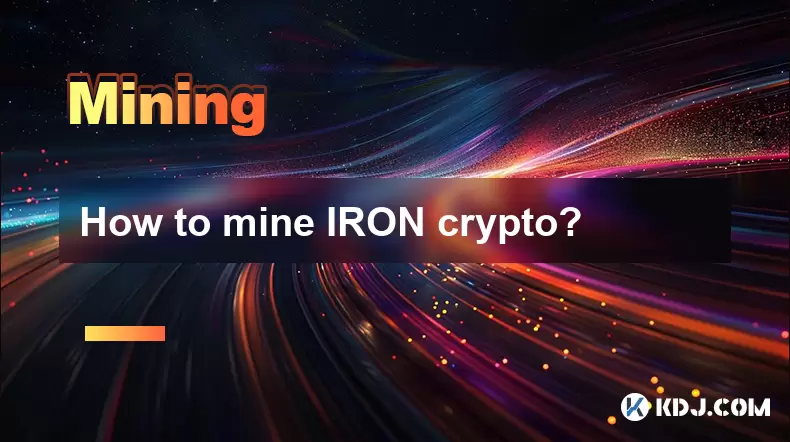
How to mine IRON crypto?
Jul 23,2025 at 07:08pm
Understanding IRON Crypto and Its Mining MechanismIRON crypto is not a standalone blockchain-based cryptocurrency that can be mined using traditional ...

What was the highest APY for IRON mining?
Jul 23,2025 at 05:14am
Understanding IRON Token and Its Mining MechanismThe IRON token is a stablecoin that operates within the Iron Finance ecosystem, primarily on blockcha...

What is impermanent loss in IRON pools?
Jul 23,2025 at 09:00am
Understanding Impermanent Loss in the Context of IRON PoolsImpermanent loss is a phenomenon that affects liquidity providers in decentralized finance ...

How to claim rewards from IRON mining?
Jul 23,2025 at 02:21pm
Understanding IRON Mining and Reward MechanismsIRON Finance operated as a decentralized finance (DeFi) protocol on the Polygon and Binance Smart Chain...

How to start mining IRON on Polygon?
Jul 23,2025 at 08:00pm
Understanding IRON and Its Role on PolygonIRON is a decentralized, algorithmic stablecoin designed to maintain a 1:1 peg with the US dollar. It operat...

How does IRON yield farming work?
Jul 23,2025 at 10:14pm
Understanding IRON Yield Farming and Its Core MechanismIRON yield farming is a decentralized finance (DeFi) strategy that allows users to earn rewards...

How to mine IRON crypto?
Jul 23,2025 at 07:08pm
Understanding IRON Crypto and Its Mining MechanismIRON crypto is not a standalone blockchain-based cryptocurrency that can be mined using traditional ...
See all articles

























































































